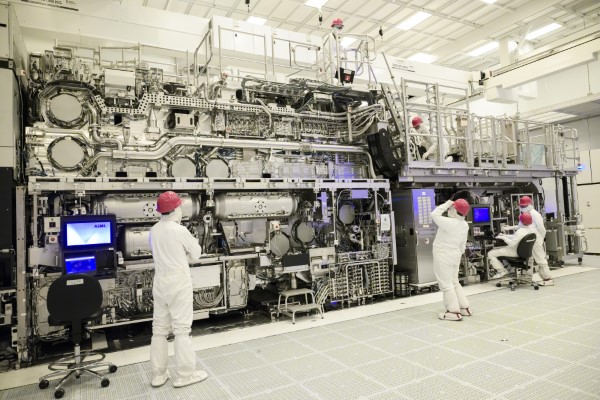When Intel cut the ribbon on Mod3, a $3 billion expansion of the company’s D1X development factory west of Portland, the semiconductor giant’s investments in Oregon had reached a staggering $52 billion in a history going back nearly half a century. Intel’s Hillsboro operation — employing some 22,000 tech workers spread across four sprawling campuses — is its single-biggest manufacturing site and is known as the company’s U.S. “innovation hub” for semiconductor research, technology development and manufacturing.
“For the last 47 years, Intel has been investing and innovating in Oregon,” said Ann Kelleher, Intel executive vice president and general manager of the company’s Technology Development Group. “Our presence in Oregon,” Kelleher added, “is our largest in the world.”
That was two years ago. Now, with semiconductor development taking center stage as an urgent national priority, the company based in Santa Clara, California, is at it again in Oregon. In October, Intel announced plans for a major expansion of its Hillsboro campus, contingent upon expected support from the Biden Administration’s CHIPS and Science Act, which offers a massive pot of federal funding to support chipmaking. After the government agreed in March to an $8.5 billion award to Intel, the company clarified its plans, announcing that its Oregon expansion would total $36 billion.
“Our presence in Oregon is our largest in the world.”
— Ann Kelleher, Intel executive vice president
“This investment,” Intel said in a statement, “further solidifies our commitment to the Silicon Forest and rebalancing the global semiconductor supply chain.” The company added that the expansion will support “several thousand” new jobs. The state is chipping in $115 million to support Intel’s aims.
“Intel’s significant investments in Oregon reflect a shared vision of success and innovation,” said Gov. Tina Kotek. “I am excited about the positive impact that Intel’s expansions and partnerships will have on Oregon’s technology landscape and the future of our workforce. This collaboration highlights our state’s commitment to fostering economic prosperity and diversity through education and innovation.”
A Revolutionary Machine
Over the years, Intel has become an anchor of Oregon’s economy. In addition to the thousands of workers the chipmaker employs directly, its total economic footprint includes more than 105,000 indirect jobs, $10 billion in annual labor income and $19.3 billion in annual GDP, according to company data. In 2022, Intel spent more than $4 billion with more than 500 suppliers statewide.
Intel says its unfolding investments will help to ensure that Oregon and the Pacific Northwest remain a hub for technology development. Highlighting the company’s agenda is the recent installation of what it calls “the world’s first high-numerical aperture extreme ultraviolet (high-NA EUV) lithography tool,” meticulously designed over decades to make silicon chips more powerful and more efficient. Intel calls the hulking machine the most complicated manufacturing tool humans have ever built.
“This new transistor tool,” said a company release, “will forever change the chip industry,” allowing Intel to deliver unprecedented precision and scalability in chip manufacturing.
Officials say Intel has worked proactively to prepare skilled workers for the new jobs it’s creating. The company partners with Oregon State University, Portland State University, the University of Oregon and others to support workforce development through research programs, internship and scholarship opportunities and collaboration around curriculum development. Intel also collaborates with Portland Community College, Washington County and the City of Hillsboro through a two-week Quick Start program that includes accelerated career preparation and hands-on learning for future technicians.
In addition, Intel offers a 16-to-20-week paid “returnship” for experienced professionals ready to return to the workforce after having taken at least a one-year break for starting or raising a family, military service, volunteering, caring for family, self or teaching.
State Incentives Deliver
Intel’s ambitious expansion isn’t occurring within a vacuum. Semiconductors represent Oregon’s biggest export, accounting for some $14 billion in 2022, and the state supplies an estimated 15% of the country’s semiconductor workforce. In July of 2023, Oregon lawmakers approved a package of more than $500 million for grants, loans and tax credits to encourage new investments by chipmakers, with state economic officials later projecting the new state supports could trigger some $40 billion in new semiconductor investments that could potentially create more than 6,000 new jobs.
“When we look back a decade from now, I truly believe we will be proud of this effort and the positive impact it will make for Oregonians and our country,” said Gov. Kotek in a statement.
 “The most complicated manufacturing tool humans have ever built.”
“The most complicated manufacturing tool humans have ever built.”
Photo courtesy of Intel
In addition to the Intel award, 14 other companies are currently being funded by the new incentives. Other recipients include Jireh Semiconductor ($39 million), equipment maker Lam Research Corporation ($22 million) and Stratacache ($19 million).
Massachusetts-based Analog Devices, approved for a $12 million incentives package, recently expanded its semiconductor wafer fab in Beaverton, the company’s biggest, to the tune of more than $1 billion. The company says the investment expands cleanroom space to 118,000 sq. ft. and nearly doubles internal manufacturing of products of products running on the 180-nanometer technology mode and above. The company says it plans to create “hundreds” of new jobs, adding to a workforce that numbers close to 1,000.
“By expanding ADI’s Beaverton facility, we are increasing our production capacity in critical industries, boosting domestic manufacturing in line with the vision of the CHIPS Act, and enhancing the global resiliency of ADI’s hybrid manufacturing model,” said Vincent Roche, ADI’s CEO and Chair. “While our investment in Beaverton will facilitate these goals, they will be achieved through the incredible dedication and talent of ADI’s existing workforce and further tapping into Oregon’s strong talent pool.”

